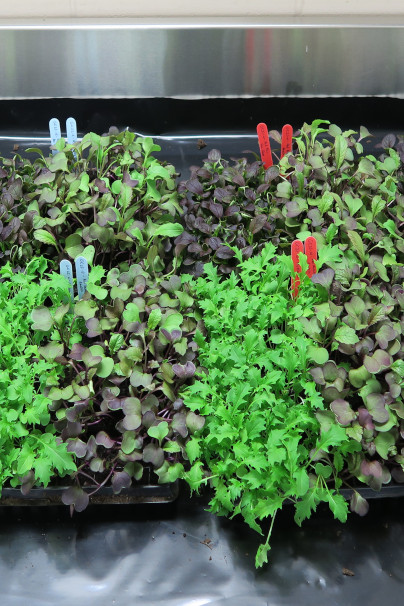Set up an interview
Media Relations
Agriculture and Agri-Food Canada
1-866-345-7972
aafc.mediarelations-relationsmedias.aac@agr.gc.ca
Field-grown fruits and vegetables use only natural sunlight, while those in greenhouses can also use supplemental lighting, known as "full spectrum" light. The only energy efficient light source for increasingly popular indoor plant production and vertical farming systems are LED (light emitting diode) lights.
Because LEDs are single wavelength, they can be combined (that is, red, blue and amber light) to provide various full spectra of light required for plants to make their own nutrients. Not all wavelengths are equally important however, and it was unknown if LED light produced the same nutrients as natural light – until now. Agriculture and Agri-Food Canada (AAFC) scientists recently discovered LEDs not only increase plant yield, but can significantly improve nutritional quality.
While previous lighting reports have focused on fruits (with LEDs used as supplementary lighting), studies analyzing LEDs for microgreens and other vegetables are limited. AAFC research scientist Dr. Rong Cao, along with technicians Dr. Lili Mats, Dr. Ronghua Liu, Dr. Zhanhui Lu, Dr. Oday Alrifai and Dr. Honghui Zhu from the Guelph Research and Development Centre as well as Drs. Xiuming Hao and Jason Lanoue, with the help of Celeste Little and Quade Digweed and a team of greenhouse workers from the Harrow Research and Development Centre, partnered with Dr. Massimo F. Marcone from the Department of Food Science at the University of Guelph.
Together, they studied combinations of red, blue, and amber LED (rbaLED) lights in different ratios to see how they would affect the production of carotenoids in eight Brassica microgreens, a plant family consisting of mainly cabbage varieties. Carotenoids are nutrients that include a type of vitamin A found only in plants as well as antioxidants that are crucial in helping reduce age-related macular degeneration (eye disorder causing vison problems).
They discovered that under increasing amber-blue and decreasing red light, the total carotenoid content increased from 20 to 44 percent and individual carotenoids increased from 10 to 55 percent. Further study demonstrated that these lights actually activated the genes that produce carotenoid antioxidants. The scientists also proved that overall antioxidant levels increased under this higher amber and blue light combination, indicating the importance of these lights for improving the nutritional value of microgreens.
"By increasing amber-blue LED lights while decreasing red, microgreens showed increased production of antioxidants, particularly the carotenoid nutrient. This discovery shows that there is great potential for LED lights to improve the nutritional quality of plants and therefore increase options for growers, consumers and northern communities that depend on indoor food production systems."
- Dr. Xiuming Hao, Research Scientist, Agriculture and Agri-Food Canada
For the first time ever, this study demonstrates that amber LED light is instrumental to carotenoid production, representing a novel approach to producing antioxidant-rich microgreens. Understanding the effects of red, blue, and amber LED lights on gene expression and the underlying cellular and molecular processes could lead to producing microgreens and possibly other produce with increased health-promoting antioxidants. This could play an important role in personalized nutrition, increasing options for growers, consumers and northern communities relying on indoor agricultural production.
Key discoveries/benefits
- Red, blue, and amber LED lights play an important role in increasing the yield and nutritional quality of greenhouse-grown plants. Increasing amber-blue lights and decreasing red light has shown to increase carotenoid production in Brassica microgreens, resulting in antioxidant-rich plants.
- This discovery could lead to the production of microgreens and other produce with increased antioxidants, a molecule that helps inhibit oxidative cell damage in the human body.
- The potential for LED lights to improve the nutritional quality of plants could lead to increased options for growers, consumers and northern communities that depend on indoor agriculture.
Photo gallery

Greenhouse-grown brassica microgreens under amber-blue lights and decreased red light to promote carotenoid production

An indoor LED light installation used during the trial

Fully grown, healthy brassica microgreens following the completed trial